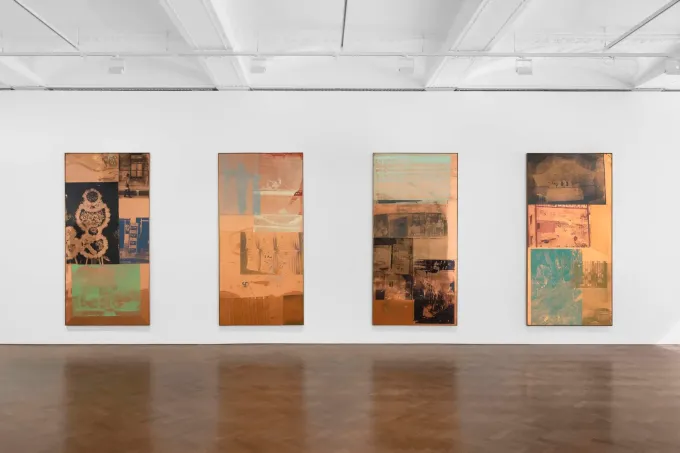
Installation view of Copperhead-Bite IX / ROCI CHILE, Copperhead-Bite V / ROCI CHILE, Copperhead-Bite IV / ROCI CHILE, and Copperhead-Bite XII / ROCI CHILE (all 1985) at Thaddaeus Ropac, London, May 2023.
Alchemy at Thaddaeus Ropac London, May 26–July 29, 2023
Alchemy
Featuring Joseph Beuys, Anselm Kiefer, Sigmar Polke, Robert Rauschenberg, Sturtevant, Emilio Vedova and Andy Warhol
Thaddaeus Ropac London
May 26 – July 29, 2023
Alchemy is a symbol for the artist... you have to destroy and then recreate. — Anselm Kiefer
Bringing together major works by some of the most influential European and American artists of the post-war and contemporary periods, Alchemy examines the enduring fascination with material transformation and alchemical thinking in artmaking. The group exhibition features works by artists who have engaged with alchemical ideas at key moments in their practice, including Joseph Beuys, Anselm Kiefer, Sigmar Polke, Robert Rauschenberg, Sturtevant, Emilio Vedova and Andy Warhol. Assembling a group of art- historically significant works, including many shown for the first time in the UK, the exhibition highlights how ideas of material, artistic and philosophical transmutation both inform, and are redefined by, these pioneers of art.
While typically associated with the quest to transform base metals into gold or find a universal cure for disease, alchemy has accrued rich material and symbolic associations as it has evolved across different cultural and temporal contexts. Known as the 'Great Art' (Ars magna), it has provided rich subject matter for artists across the centuries, from Albrecht Dürer to 20th-century Surrealists. Conceiving the artist's studio as a laboratory, this exhibition explores the legacies of alchemy through the distinct perspectives of each artist as they undertake experimental modes of engaging with the world around them.
Striving to gain a greater understanding of the human body, alchemical traditions frequently employed 'base' bodily fluids, such as urine, in complex experiments. In the 1960s and 1970s, Andy Warhol (1928–87) undertook his own artistic experiment, appropriating the alchemical substance to produce a series of audacious Piss paintings. He invited members of his circle to provide samples or urinate directly onto the canvases. One of the earliest of these Piss paintings, created in 1961, is included in the exhibition, alongside a monumental canvas extending almost five metres in length.
Created in 1983 during the German artist's self-described 'alchemical' turn, works from the major Katastrophentheorie series by Sigmar Polke (1941–2010) demonstrate both his extensive experimentation with pigments and his thematic engagement with science and mathematics, disciplines with their roots in medieval alchemy. Articulated in resins coloured with Polke's signature purple pigment, the canvases bear graphic translations of the principles of catastrophe theory - the idea that one small fluctuation in circumstances might have vast consequences elsewhere.
In the Venezia muore cycle of 1992, Emilio Vedova (1919–2006) harnesses the agency of his chosen materials as he pours water onto canvases prepared with acrylic and nitro paint. The water is repelled by these substances as it simultaneously corrodes the surface of the painting, creating ghostly effects that echo salt-like crystalline structures.
The stronger things need to be said, the more you can be sure of the material, the technique will be found. The artist has an eternal sense of investigation. — Emilio Vedova
American artist Robert Rauschenberg (1925–2008) also embraces the unpredictability of his materials in his experimental metal paintings of the 1980s and 1990s. Just as alchemists sought to transform base metals through chemical reactions, Rauschenberg applies 'corrosives' or tarnishing agents to thin sheets of copper, aluminium and brass that bear hand-painted elements and silk-screened photographic images, creating unexpected colouristic variations.
I put my trust in the materials that confront me, because they put me in touch with the unknown. — Robert Rauschenberg
Understanding art as a vehicle for social and spiritual renewal in the context of post-war Germany, Joseph Beuys (1921–86) celebrates the alchemical potential of materials to pass through different physical states, drawing parallels with the possibility of transforming society itself. His self-termed 'shamanistic' practice encompasses the creation of his own materials, such as the oil-based admixture Braunkreuz, which takes on a highly symbolic function within his oeuvre.
Repetitions of other artists' work by Sturtevant (1924–2014) reflect a distinct approach to the concept of alchemical transmutation. The American artist interrogates ideas about originality, authorship and canonisation in structures of artmaking through the differences that emerge in the process of remaking. Her reinterpretations of Beuys's work presented in the exhibition assert Sturtevant's exploration of the possibilities and limitations of conceptual transformation, paradoxically, through her signature process of repetition.
For Anselm Kiefer (b.1945), alchemy is an enduring source of inspiration that informs both the materiality and subject matter of his art. The 'base' metal lead has become a primary material in his practice, valued for its alchemical potential to be transformed into gold, which the artist sees as an analogy for the possible renewal of humankind.
Tracing the legacies of alchemy through this exemplary body of post-war and contemporary art, the exhibition illuminates the unique technical, thematic and philosophical innovations of each artist and their continued relevance in art-historical conversations today.
For more information: https://ropac.net/exhibitions/664-alchemy/
